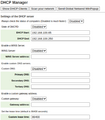Difference between revisions of "Server Manager2 create panel for contrib"
Tags: Mobile edit Mobile web edit |
Tags: Mobile edit Mobile web edit |
||
| Line 115: | Line 115: | ||
\} | \} | ||
</syntaxhighlight> | </syntaxhighlight> | ||
| + | |||
| + | So, we'll create the following files for the new SM2 panel(s) for the DHCPManager contrib. | ||
| + | |||
| + | #/usr/shared/smanager/lib/SrvMngr/Controller/dhcpman.pm | ||
| + | #/usr/shared/smanager/lib/SrvMngr/I18n/modules/dhcpman/en.lex | ||
| + | #/usr/shared/smanager/themes/default/templates/dhcpman.html.ep | ||
| + | #/usr/shared/smanager/themes/default/templates/partials/_dhcpm_scan.html.ep | ||
| + | #/usr/shared/smanager/themes/default/templates/partials/_dhcpm_winpopup.html.ep | ||
| + | #/usr/shared/smanager/themes/default/templates/partials/_dhcpm_leases.html.ep | ||
==The Controller File== | ==The Controller File== | ||
Revision as of 13:08, 9 January 2022
Introduction
Server Manager 2 is based on the perl library Mojolicious and has as its central tenet that the html structure is kept separate from the content that is displayed, giving a lot of flexibility. It has a structure so that the web pages can have a theme applied independant of the content. Behind the scenes a non blocking web server does the actual work, and comes with lots of additional plugins.
Initially the default theme mimics the current Server Manager pages (which is based on formMagick), however a new theme has also been developed which is based on AdminLTE.
If you follow the rules in this document, then your page should work in both themes without any trouble!
I am using the example of the DHCP Manager contrib which has a simple initial panel and 3 subsidiary panels.
Directory Structure
/usr/share/smanager
├── conf - contains preferences file.
├── data
├── lib
│ └── SrvMngr
│ ├── Controller - contains .pm files one for each module
│ ├── I18N
│ │ └── Modules
│ │ ├── Backup
...snip ....one for each module - contains translation strings
│ │ ├── Xt_geoip
│ │ └── Yum
│ ├── Model
│ └── Plugin
├── log
├── script
├── t
└── themes
└── default
├── public
│ ├── css
│ ├── images
│ └── js
└── templates - top level .html.ep file (one per theme)
├── layouts - contains one .html.ep file for each module
└── partials - contains partial files - as many as required for modules
(generally corresponds to subsidiary panels)
So each module (contrib in this case), consists of at least 3 files:
- .pm file of perl in the controller directory to gather up the content into a data structure (generally a hash or array)
- .lex or .pm in the I18n/modules directory consisting of translation strings. I think that the system will generate the .pm file from the .lex file, but will use a .pm file if it is there (need to check this with @michel).
- .html.ep file in the themes/default/templates/layout directory being the top level panel plus includes to subsidiary panels.
- In addition there may be "extra" .html.ep files in the themes/default/templates/layout/partials directory, which are conditionally included in the top level panel code.
Configuration/Preferences File
This is found in /usr/share/smanager/conf/srvmngr.conf. Initial contents are:
#------------------------------------------------------------
# !!DO NOT MODIFY THIS FILE!!
#
# Manual changes will be lost when this file is regenerated.
#
# Please read the developer's guide, which is available
# at http://www.contribs.org/development/
#
# Copyright (C) 1999-2006 Mitel Networks Corporation
#------------------------------------------------------------
{
# configuration file for Mojolicious Server-Manager2 application
#
secrets => ['blah blah'],
theme => 'default',
# session timeout
timeout => '300',
hypnotoad => {
## adresses and ports listened
listen => ['http://127.0.0.1:982'],
proxy => 1,
pid_file => '/var/run/smanager.pid',
## process number based on CPU number [x 2]
workers => (`grep processor /proc/cpuinfo | wc -l` * 2),
## connections queue size, per worker
accepts => 100,
## propriétaire et groupe du serveur
user => 'admin',
group => 'admin'
},
# is js-jquery available
hasJquery => 1,
modules_dir => 'lib/SrvMngr/Controller',
webapp => 'smanager',
mode => 'production',
debug => 0,
}
If you change the "mode" => "development", then when you get a runtime error it will show you the context. Otherwise it just gives a generic error message.
The file is templated so every time you reload the rpm then it will get set to "production", unless you add a custom template to:
"/etc/e-smith/templates/usr/share/smanager/conf/srvmngr.conf" to override it.
Later you will see how to access the "debug" property in your perl code which can be used to switch on and off diagnostic information.
Here's the contents of my "/etc/e-smith/templates-custom/usr/share/smanager/conf/srvmngr.conf/30other":
modules_dir => 'lib/SrvMngr/Controller',
webapp => 'smanager',
mode => 'development',
debug => 1,
\}
So, we'll create the following files for the new SM2 panel(s) for the DHCPManager contrib.
- /usr/shared/smanager/lib/SrvMngr/Controller/dhcpman.pm
- /usr/shared/smanager/lib/SrvMngr/I18n/modules/dhcpman/en.lex
- /usr/shared/smanager/themes/default/templates/dhcpman.html.ep
- /usr/shared/smanager/themes/default/templates/partials/_dhcpm_scan.html.ep
- /usr/shared/smanager/themes/default/templates/partials/_dhcpm_winpopup.html.ep
- /usr/shared/smanager/themes/default/templates/partials/_dhcpm_leases.html.ep

